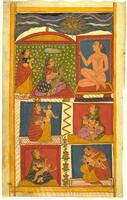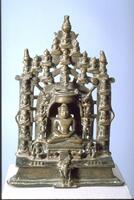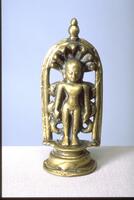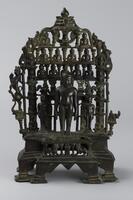17 UMMA Objects
17 UMMA Objects

Indian (Indian (South Asian))
Ambika
17th century
Gift of Dr. and Mrs. Leo S. Figiel and Dr. and Mrs. Steven J. Figiel.
1975/2.114
![The jina Malli sits in the lotus position on an inlayed cushion on a tiered throne. Seated with his hands folded in a gesture of meditation, he is surrounded by a number of figures representing other jinas, attendants and demigods. In the center in front of the throne sits the goddess Ambika with a child on her lap. On the first tier of the throne sit two figures that may represent donors. On the next left are nine mounds representing the nine planets [navagraha], five to his right and four to his left. At the base of his seat are two stylized lions and this is flanked by a male and female demigod. On the arch surrounding the figure at his level a standing jina figure is to each side and cauri bearer is on the outside of each of them. At his shoulders, the cross bars of the throne back end in stylized makara heads with jewels hanging from their mouths. A seated jina adorns the arch to each side of his head and elephants surmount them with an umbrella over his head with a dancing figure atop it. The who The jina Malli sits in the lotus position on an inlayed cushion on a tiered throne. Seated with his hands folded in a gesture of meditation, he is surrounded by a number of figures representing other jinas, attendants and demigods. In the center in front of the throne sits the goddess Ambika with a child on her lap. On the first tier of the throne sit two figures that may represent donors. On the next left are nine mounds representing the nine planets [navagraha], five to his right and four to his left. At the base of his seat are two stylized lions and this is flanked by a male and female demigod. On the arch surrounding the figure at his level a standing jina figure is to each side and cauri bearer is on the outside of each of them. At his shoulders, the cross bars of the throne back end in stylized makara heads with jewels hanging from their mouths. A seated jina adorns the arch to each side of his head and elephants surmount them with an umbrella over his head with a dancing figure atop it. The who](/media/W1siZiIsIjIwMjIvMDUvMjUvMnp2bHlnYzJuX2RlZmF1bHQuanBnIl0sWyJwIiwidGh1bWIiLCIyNDB4MjAwIl1d?sha=41927aa38309f645)
Indian (Indian (South Asian))
Malli shrine, dated VS 1528 [1471 A.D.]
1471
Gift of Dr. and Mrs. Leo S. Figiel and Dr. and Mrs. Steven J. Figiel.
1975/2.121

Artist Unknown, India, Rajasthan, Sirohi School
Digambara Jain manuscript page: Jina and worshipper
18th century
Gift of Dr. and Mrs. Leo S. Figiel and Dr. and Mrs. Steven J. Figiel.
1975/2.165

Artist Unknown, India, Rajasthan or Gujarat, Jain
Column with Four Jinas and Attendants (Jain Marble Column)
1100 – 1299
Museum purchase made possible by the Margaret Watson Parker Art Collection Fund
2004/1.151

Indian (Indian (South Asian))
Caturvimsati Pata (Shrine of the 24 Jinas)
1464
Gift of Dr. and Mrs. Leo S. Figiel and Dr. and Mrs. Steven J. Figiel.
1975/2.120

Artist Unknown, India, Rajasthan, Sirohi School
Digambara Jain manuscript page: Jina and battle scene
18th century
Gift of Dr. and Mrs. Leo S. Figiel and Dr. and Mrs. Steven J. Figiel
1975/2.168

Artist Unknown, India, Rajasthan, Sirohi School
Digambara Jain manuscript page: Jina venerated by a community of laymen
18th century
Gift of Dr. and Mrs. Leo S. Figiel and Dr. and Mrs. Steven J. Figiel.
1975/2.169
![Two distinct registers divide a page in half. At the top, a yellow-orange colored nude jina sits in lotus position upon a three tiered throne [a patterned blue level at the bottom on feet, with an orange section with gold and red decoration and a green level at the top with gold vertical stripes]. He sits against a red background adorned with a pattern of three white dots. The background takes the shape of an elegant cusped arch with a green and white pattern along its outside with a gold pattern at its sides. To the right of the seated figure a nude Digambara monk sits with his legs folded and one knee up on a less elaborate throne with a lota or pot at the corner and a crossed bookstand to the side holding a book with some devanagari writing on it. He raises his right arm and holds his left to his ear.<br />
Placed under a band of curving yellow stripes, the bottom register represents animals in a landscape. At the bottom are clumps of grass with four stylized mountain forms in blue at the right. Above the Two distinct registers divide a page in half. At the top, a yellow-orange colored nude jina sits in lotus position upon a three tiered throne [a patterned blue level at the bottom on feet, with an orange section with gold and red decoration and a green level at the top with gold vertical stripes]. He sits against a red background adorned with a pattern of three white dots. The background takes the shape of an elegant cusped arch with a green and white pattern along its outside with a gold pattern at its sides. To the right of the seated figure a nude Digambara monk sits with his legs folded and one knee up on a less elaborate throne with a lota or pot at the corner and a crossed bookstand to the side holding a book with some devanagari writing on it. He raises his right arm and holds his left to his ear.<br />
Placed under a band of curving yellow stripes, the bottom register represents animals in a landscape. At the bottom are clumps of grass with four stylized mountain forms in blue at the right. Above the](/media/W1siZiIsIjIwMjIvMDUvMjUvMXoxZ2ZnNHN6Zl9kZWZhdWx0LmpwZyJdLFsicCIsInRodW1iIiwiMjQweDIwMCJdXQ?sha=54d3764ea6247e3b)
Artist Unknown, India, Rajasthan, Sirohi School
Jain Tirthankara and a monk with animal forest scene, no. 12 from a Digambara series
18th century
Gift of Dr. and Mrs. Leo S. Figiel and Dr. and Mrs. Steven J. Figiel
1975/2.178

Indian (Indian (South Asian))
Parshvanatha (small folk bronze)
20th century
Gift of Dr. and Mrs. Leo S. Figiel and Dr. and Mrs. Steven J. Figiel.
1975/2.122

Indian (Indian (South Asian))
Jaina altar piece of the 24 [Caturvimsati] Jinas: with standing nude figure of Mahavira cast in the round occupying central area of base, flanked by small tirthankaras; incsribed but unread. From Mysore, Karnataka.
1400 – 1599
Gift of Dr. and Mrs. Leo S. Figiel and Dr. and Mrs. Steven J. Figiel
1978/2.118

Indian (Indian (South Asian))
Jina, fragment of a larger shrine
15th century
Gift of Dr. and Mrs. Leo S. Figiel and Dr. and Mrs. Steven J. Figiel.
1975/2.123

Indian (Indian (South Asian))
Kalpasutra manuscript, leaf: A Jaina monk (fol. no. 2r)
15th century
Gift of Professor Walter M. and Nesta R. Spink for the James Marshall Plumer Memorial Collection
1980/2.247
Loading…
